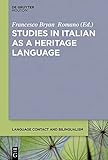Studies in Italian as a Heritage Language / ed. by Francesco Bryan Romano.
Material type: TextSeries: Language Contact and Bilingualism [LCB] ; 25Publisher: Berlin ; Boston : De Gruyter Mouton, [2023]Copyright date: ©2023Description: 1 online resource (XV, 324 p.)Content type:
TextSeries: Language Contact and Bilingualism [LCB] ; 25Publisher: Berlin ; Boston : De Gruyter Mouton, [2023]Copyright date: ©2023Description: 1 online resource (XV, 324 p.)Content type: - 9783110759518
- 9783110759624
- 9783110759587
- 458 23/eng/20230512
- PC1066 .S78 2023
- online - DeGruyter
- Issued also in print.
| Item type | Current library | Call number | URL | Status | Notes | Barcode | |
|---|---|---|---|---|---|---|---|
 eBook
eBook
|
Biblioteca "Angelicum" Pont. Univ. S.Tommaso d'Aquino Nuvola online | online - DeGruyter (Browse shelf(Opens below)) | Online access | Not for loan (Accesso limitato) | Accesso per gli utenti autorizzati / Access for authorized users | (dgr)9783110759587 |
Frontmatter -- Acknowledgments -- Contents -- List of figures -- List of tables -- Introduction -- Chapter 1 Heritage language development: Dominant language transfer and the sociopolitical context -- Part I: Experimental studies -- Chapter 2 Ultimate attainment in long-immersed heritage Italian immigrants: Syntactic and semantic knowledge of direct object clitics and partitive ne -- Chapter 3 Grammatical competence in adult heritage speakers of Italian and adult immigrants: A comparative study -- Chapter 4 Ultimate attainment of gender in heritage and L2 Italian -- Chapter 5 Auxiliary selection in heritage speakers of Italian -- Chapter 6 The acquisition of syntactic structures in heritage Italian: Assessing the role of language exposure at critical periods -- Chapter 7 The expression of (deontic and epistemic) modality in Italian as heritage language in Germany -- Part II: Observational studies -- Chapter 8 Italian as heritage language in third generations on social networks: Morphosyntactic code-switching features -- Chapter 9 Discourse markers in heritage Italian spoken in Flanders -- Chapter 10 Auxiliary selection in Italo-Romance heritage languages: Argentina and the UK -- Conclusion and future directions -- Index
restricted access online access with authorization star
http://purl.org/coar/access_right/c_16ec
The book is dedicated to the linguistic, psycholinguistic, and ethnolinguistic dimensions of Italian as a heritage language spoken by minorities in the Americas and Europe. The contributions deepen our understanding of heritage language bilingualism in general, especially by comparing the acquisition of inflectional morphology in Italian with the processes at play in other heritage languages.
Issued also in print.
Mode of access: Internet via World Wide Web.
In English.
Description based on online resource; title from PDF title page (publisher's Web site, viewed 25. Jun 2024)


